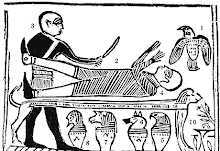I've been thinking about some of the gnostic or mystical practices in early Mormonism, and I've wondered, "Why don't we do that anymore?"
For example, Brigham Young is quoted in History of the Church (7:285) as saying about seer stones, "[The Prophet] Joseph [Smith] said there is a stone for every person on Earth." Further, he said, "The president of the priests has a right to the Urim and Thummim, which gives revelation."
 At left, one of Joseph's seer stones which was present on the altar of the Manti Temple at it's dedication.
At left, one of Joseph's seer stones which was present on the altar of the Manti Temple at it's dedication.So doesn't it sounds like all Elders Quorum presidents should have a seer stone? Why did we give this up? Who wouldn't want one?



1 comment:
While this post is somewhat old and I doubt anyone will ever see my comment, I feel compelled to say something here on the subject should some future vistor stumble upon this blog and desire an answer to poster's question:
In the Book of Mormon, in the eighth chapter of Mosiah, Ammon speaks at length about the special calling of seers, and how only those that have thus been called by God to receive revelation by the interpreters- which we know to be the Urim and Thummim, or a pair of seer stones- are able to use the interpreters in this way. Throughout the history described in the Nephite record, there would only seem to be one set of seer stones in use at any time, and only one individual at a time who can make use of them, one who Ammon suggests they seek out to translate the words found in the twenty four plates in the above mentioned chapter. Likewise, the only person to receive authoritative revelation by way of the seer stones in the Church's history was Joseph Smith himself, though there were other people at the time using stones in a similar fashion. Note in Joseph's case as well as that of the Nephite seers, the interpreters are primarily used for divinely assisted translation of documents, though obviously they can be used for other purposes.
While Brigham's statement that there is a stone for every person on Earth would appear to be confirmed by the scriptures, which say that God will reward those in Heaven with a white stone engraved with a new name, and that further this stone will function as a Urim and Thummim, these passages clearly refer to future events rather than something of import to present practices. I'm not sure what Brigham's second statement is drawn from however, as again there is generally only one seer at a time eligible to use the stones. There are a couple of instances of individuals in the scriptures requesting to use the Urim and Thummim to receive revelation from the seer who holds them, so that might be the type of situation he was talking about, but this would still limit the possession of a seer stone to the official ordained seer and revelator.
I would also like to add that I'm not sure what the poster meant by saying that the use of seer stones was 'gnostic' or 'mystical'. To my knowledge Joseph and his contemporaries didn't really use such language to describe anything about their practices, and I don't know how religious traditions which do use those words in reference to themselves relate to the nature of the Urim and Thummim (other than it is an instrument for receiving revelation from God, which I'm sure virtually every faith has in some form or another).
Post a Comment